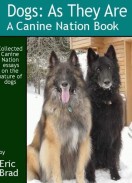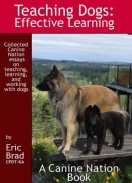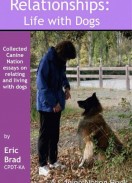 I remember being at an animal training conference 15 years ago. Many of the attendees were accompanied by their amazingly well trained dogs. On the second day, animal trainer and author Karen Pryor made an interesting observation. She said that she saw so many wonderfully behaved dogs waiting patiently for their people until seminar sessions concluded. But when the sessions ended, people would just get up and start walking out to the next session without telling their dogs about it. Attendees would just stand up when the session was over and start walking. The dog was expected to figure it out or get a tug on their leash as their owner moved away. That was the only information they received about what was happening next.
I remember being at an animal training conference 15 years ago. Many of the attendees were accompanied by their amazingly well trained dogs. On the second day, animal trainer and author Karen Pryor made an interesting observation. She said that she saw so many wonderfully behaved dogs waiting patiently for their people until seminar sessions concluded. But when the sessions ended, people would just get up and start walking out to the next session without telling their dogs about it. Attendees would just stand up when the session was over and start walking. The dog was expected to figure it out or get a tug on their leash as their owner moved away. That was the only information they received about what was happening next.I’m not sure if this was the first time I heard Karen Pryor talk about what she called “informational cues” but that short talk changed the way I interacted with my dogs from that time forward. As Karen described it, an “Informational Cue” was different than a regular cue because it is not asking the dog to do anything. It is just information. The dog gets to decide what to do about it.
Basic information
One of the first informational cues I taught my dog Tira was simple and practical. When I’m sitting with my dogs somewhere and everyone is just relaxing, I will sometimes need to get up and get a glass of water or something. I will not be gone for more than a few moments and I plan to return to sitting with the dogs. So I began saying “I’ll be back” to my dogs before getting up. My intention is to let them know that there is no reason for them to get up and follow me because I will be coming right back to my seat.
At first, the cue means nothing, as with any cue. To begin with, Tira would get up and come with me anyway. But over time, she noticed that there was no reason to get up, follow me 20 steps to the kitchen and then back, and watch me sit back down. She wasn’t told to “stay” and I didn’t tell her she was wrong if she followed me. It didn’t take long for Tira to decide that it was easier to just stay where she was when she heard “I’ll be back.” She seemed to decide that “I’ll be back” means “getting up and following dad right now is a waste of energy so don’t bother.”
Ideally, an “Informational Cue” just provides my dogs with information they can use to make their own choices as to what they do. There is no reward. There is no punishment. There is no right or wrong response. I’m just letting my dogs know what’s going on and they can do with that information what they will.
Making chatter useful
Over the years we have come up with several “Informational Cues” for our dogs. “Let’s go out” is their signal that there is an opportunity to head outside to do their business. “Dinner time” or “Breakfast” is the signal that meal preparations are starting. “Time for bed” is their signal that we’re going to bed. Anything that could help our dogs anticipate what is happening around them becomes an informational cue. It seems like we are talking to our dogs all the time.
 That’s true of most dog owners I know. We talk to our dogs a lot. The trick to making informational cues work is being consistent in what you say and what you do. Fortunately humans are creatures of habit and I’m sure most dogs have discovered their own informational cues about their owners. But it’s likely that the owners weren’t teaching them deliberately. Our dogs are always watching; trying to make sense of their world. Our dogs can sometimes develop what we may see as annoying habits when they are really just responding to our unintentional informational cues.
That’s true of most dog owners I know. We talk to our dogs a lot. The trick to making informational cues work is being consistent in what you say and what you do. Fortunately humans are creatures of habit and I’m sure most dogs have discovered their own informational cues about their owners. But it’s likely that the owners weren’t teaching them deliberately. Our dogs are always watching; trying to make sense of their world. Our dogs can sometimes develop what we may see as annoying habits when they are really just responding to our unintentional informational cues. One example of this happened in our family. A relative of my wife had a dog that would bark as soon as she got out the food bowls for the dogs’ dinners each evening. In order to stop the barking, the owner would hurry through the meal preparations and put the bowls down. Her dog had learned that “when you see the bowls, start barking because it gets the food to come faster.” If you’re a dog, that’s good information to have.
Consistent comfort
Being intentional in creating and using informational cues can also provide a less direct but more important benefit. It gives them a way to make their life more predictable and less chaotic. Consider that your dog is a different species of animal with different instincts and intuitions about the world. When they come into our human lives, their first priority is to figure out what works well for them and what does not. They want to do what’s right and avoid doing what’s wrong. Any help we can give them in making sense of life with us has to be useful and can lower their overall stress at learning to live with us..
Consistency and predictability are things that dogs prefer. Any good dog training method will tell you that you should always be consistent – yes means yes and no means no. But that consistent approach can be just as important in our everyday life. One of our frequently used informational cues is “Watch the house.” It’s something that we say as we are leaving the house to let our dogs know that they will not be coming with us but that we will return shortly. When our dogs hear that cue, there is no running to the door to be the first in the car for a ride.
I like to think of our informational cues as providing an agenda for our dogs. They don’t have to guess what is happening at any given time. We have found that a lot of our dog’s unwanted behaviour in the past seems to have been connected to them trying to figure out what to do next. The pacing, barking, unwanted pestering, and other behaviours were really just their way of trying things to see what was going on. Without clear indicators for when we were doing something and when we were just relaxing, it only makes sense that our dogs were, in their way, asking us for information.
Too familiar
It can be all too easy to think our dogs know what we think and what we are doing. Dogs do display an amazing ability to know what’s going on with us. While some people can attribute this to an uncanny ability of dogs to “read our minds”, it is far more likely that these observant creatures are just reading our actions and our habits. They are paying far more attention to what we do and how consistently we do it than even we do ourselves. It’s very possible that we assume too much from our dogs.
 Science has determined that a well trained dog has the intellectual capacity of a three year old child. If we consider our dogs in those terms, it only makes sense that we keep them informed with as many cues as we can, as often as we can, to help them stay on track and navigate their day. Regular routines, specific phrases, and even physical gestures to let them know where we are going can all make their world more predictable and easier to navigate.
Science has determined that a well trained dog has the intellectual capacity of a three year old child. If we consider our dogs in those terms, it only makes sense that we keep them informed with as many cues as we can, as often as we can, to help them stay on track and navigate their day. Regular routines, specific phrases, and even physical gestures to let them know where we are going can all make their world more predictable and easier to navigate.I guess in some ways, I see these informational cues as being polite. For all the things my dogs give me each day, it only makes sense that I try to be considerate of their point of view. Informational cues are a small courtesy that I can show my dogs to help them out through the day. These cues are so easy to train and they take little effort to use. I find that they are a great way to show my dogs respect and make their lives easier. Chances are, your dogs have picked up some informational cues from you already. If you’re like me, it won’t take much effort to add some informational cues in everyday life to make things easier. I’m sure your dogs will thank you for it!
Until next time, have fun with your dogs!
Be sure to check out our Canine Nation ebooks on Amazon, Google, Dogwise, and other ebook sellers. Join our conversation on Facebook in the Canine Nation Forum!
These Canine Nation ebooks are now available –



Available from Dogwise!
Photo credits –
Curious- copyright Alexandra Johansson
Pug- copyright Eddy van 3000
Relax – Public Domain
Couch (Featured Image) – copyright the paw pad



Available from Dogwise!
Photo credits –
Curious- copyright Alexandra Johansson
Pug- copyright Eddy van 3000
Relax – Public Domain
Couch (Featured Image) – copyright the paw pad
